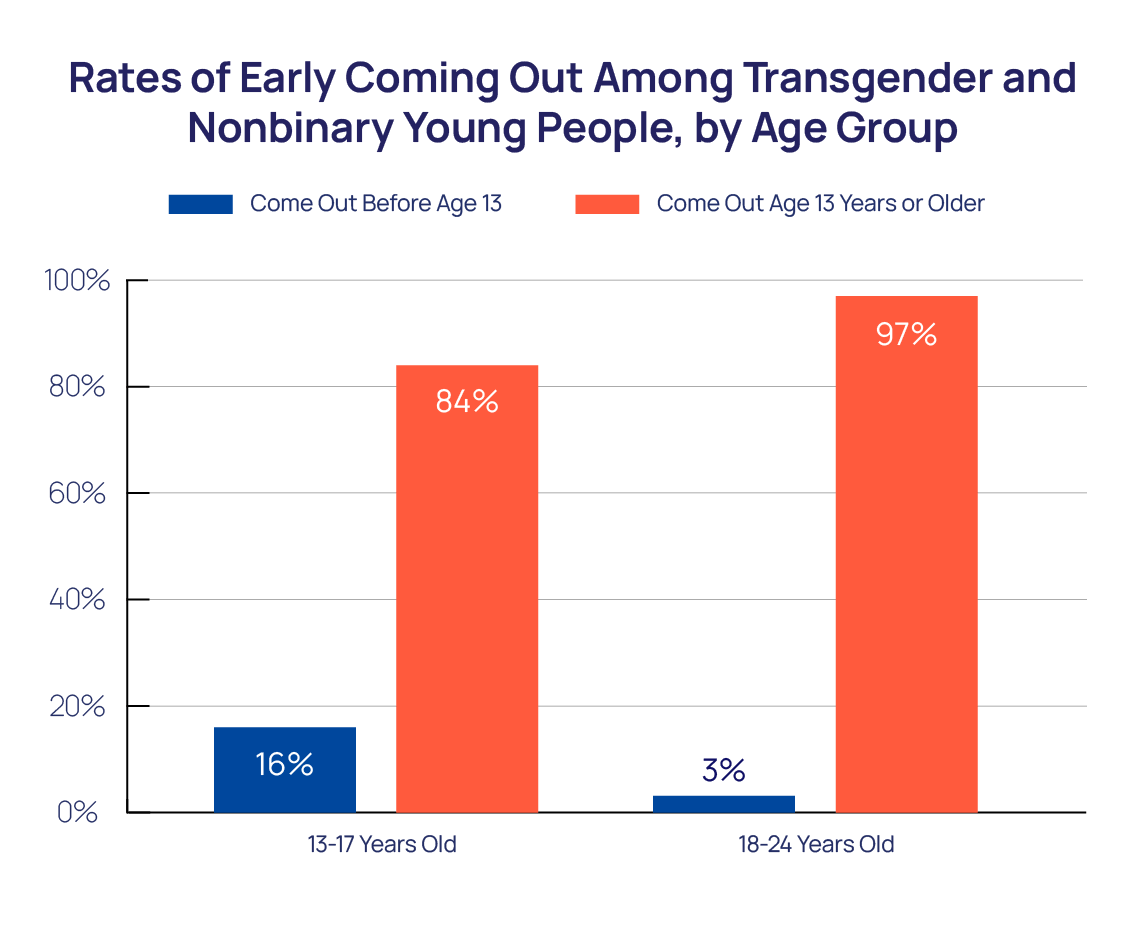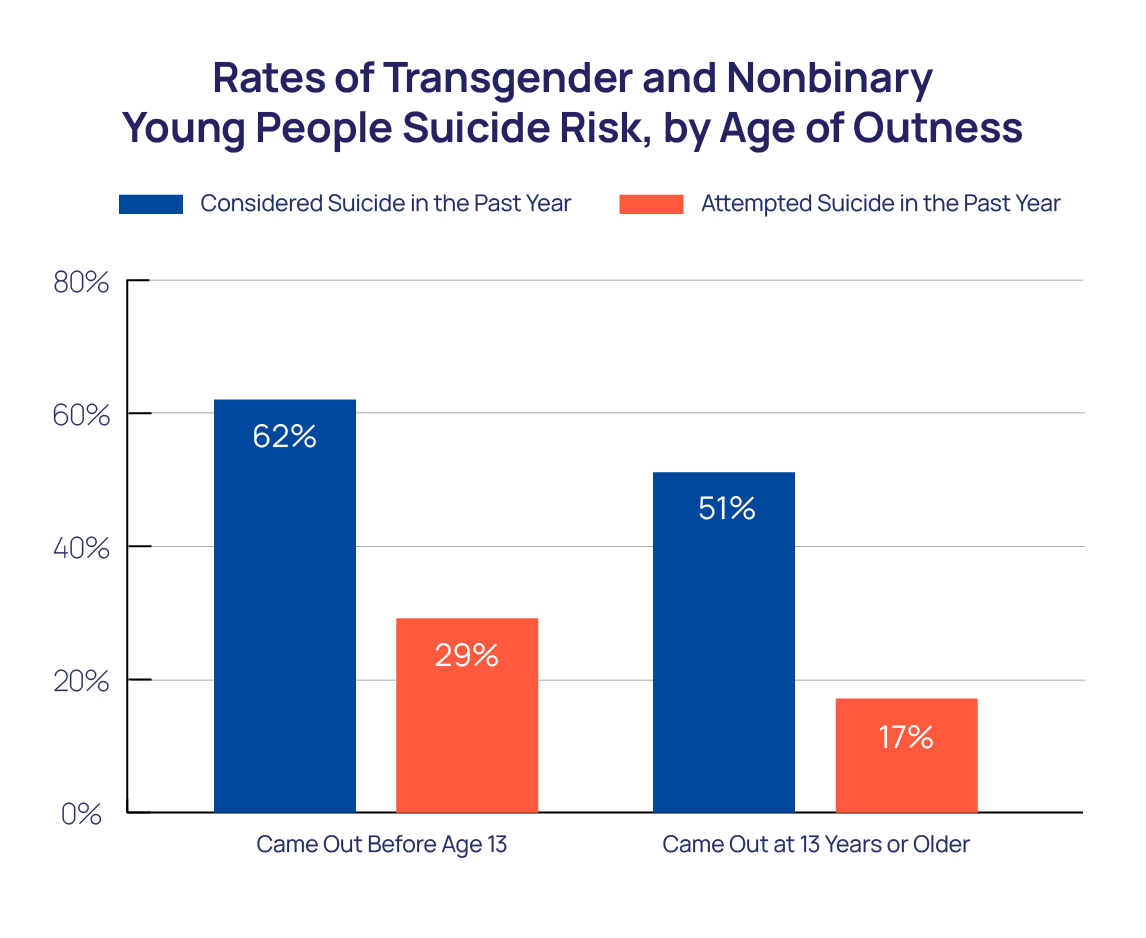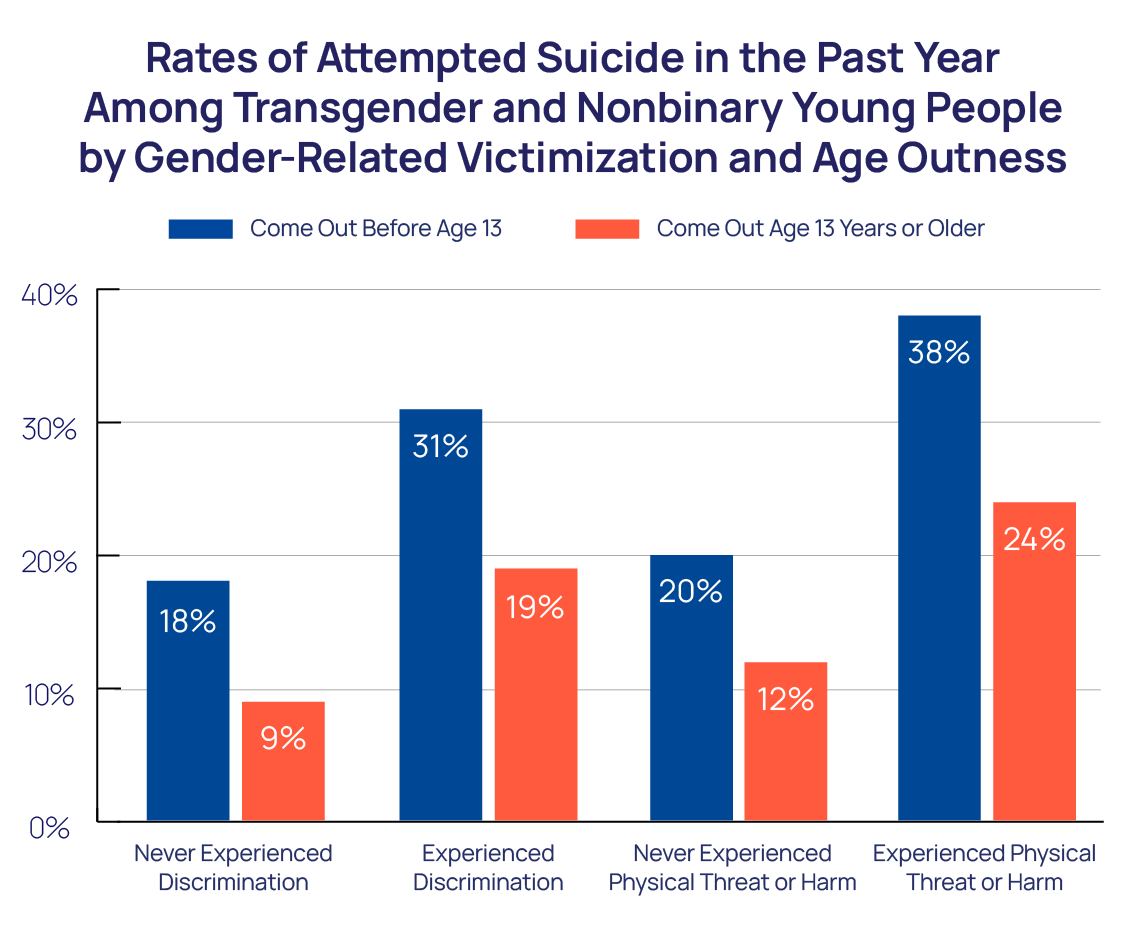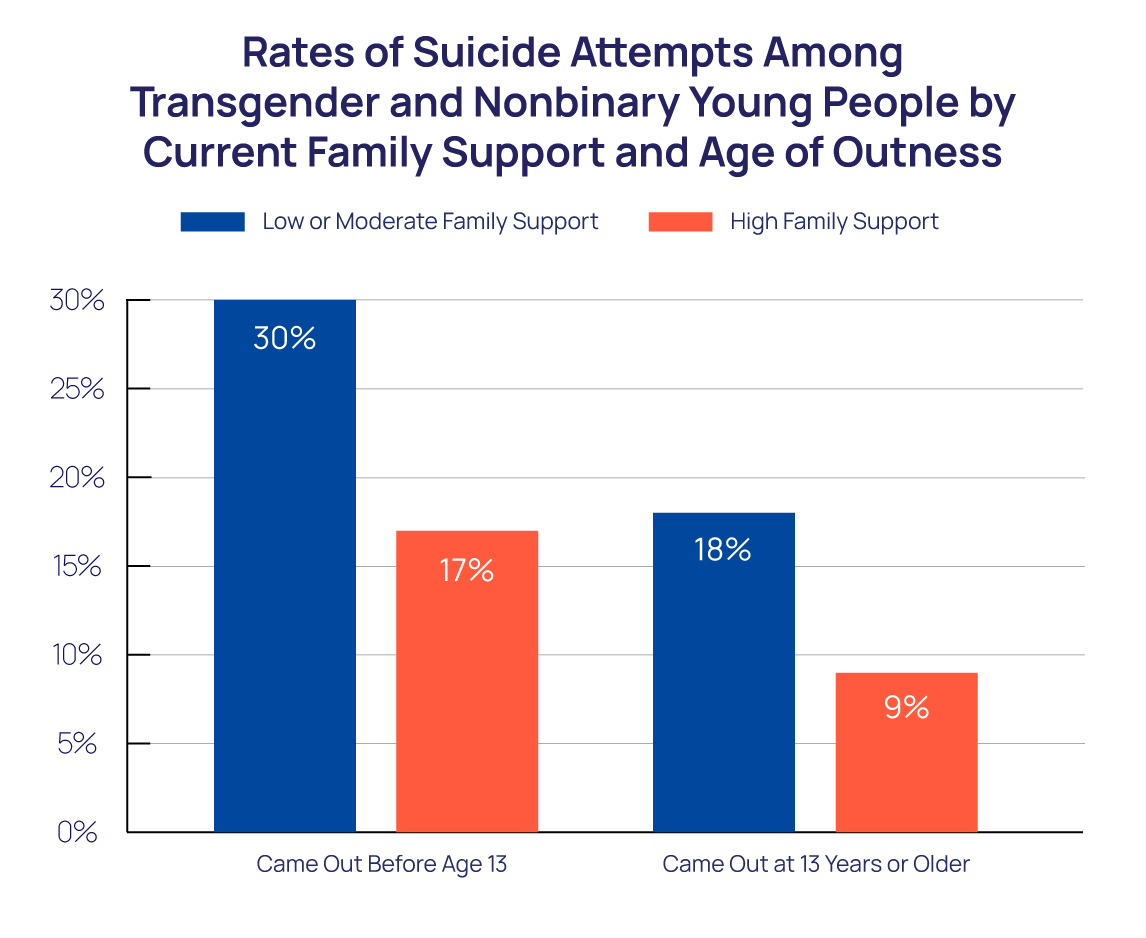Youth's Lives Every Day
Background
“Coming out” is everyday language for the process of sharing one’s sexual orientation or gender identity with other people. The decision of when and how to come out – or not – is deeply personal, and can change over the course of an individual’s lifetime. For transgender and nonbinary (TGNB) individuals, sharing the details of one’s gender identity or history with friends, family, and acquaintances can be complex. On a basic level, TGNB people do not always have the option to come out to others — sometimes they are forcibly outed by their documentation, medical records, or physical appearance (Beemyn & Bauer, 2015). TGNB people may also only be out about their gender identity in certain spaces or spheres of their life where they feel safe being open with others (Klein et al., 2015). While little research has specifically examined gender identity outness, outness of ones’ LGBTQ identity more broadly is associated with mixed mental health outcomes among young people. Sexual orientation outness is associated with high levels of suicide risk among LGBTQ young people, despite society becoming more LGBTQ-affirming over time (Meyer et al., 2021). This is likely due to increased exposure to anti-LGBTQ language, discrimination, and violence after one comes out as LGBTQ. Indeed, LGBTQ young people who are more out about their sexual orientation report higher levels of victimization in school, compared to their peers who are less out (Kosciw et al., 2015; Poteat et al., 2022). Furthermore, given that coming out earlier places young people at greater risk for anti-LGBTQ victimization, it has therefore been associated with increased risk for suicide, as documented in our previous research brief, “Age of Sexual Orientation Outness and Suicide Risk”. However, being out about one’s LGBTQ identity can also be protective, as LGBTQ young people with higher levels of outness also report higher self-esteem and lower rates of depression (Kosciw et al., 2015). It is unclear if similar findings hold true for TGNB young people coming out about their gender identity. Using data from The Trevor Project’s 2022 National Survey on LGBTQ Youth Mental Health, this brief examines the association between a TGNB young person’s age of coming out about their gender identity and suicide risk.
Results

Transgender and nonbinary (TGNB) young people are coming out about their gender identity at younger ages. TGNB young people in our sample who were ages 13 to 17 came out, on average, at age 14 (M=14.0; SD=1.74), compared to TGNB young people ages 18 to 24 who came out, on average, at age 18 (M=18.0; SD=2.96). Overall, 11% of the sample came out before age 13. However, looking at different age groups, 17% of TGNB young people ages 13 to 17 came out about their gender identity before they were 13 years old, compared to only 3% of TGNB young people ages 18 to 24.

TGNB young people who came out before age 13 had increased odds of suicide risk. Nearly two-thirds (62%) of TGNB young people who came out before age 13 seriously considered suicide in the past year, compared to 51% of those who came out later. Additionally, 29% of TGNB young people who came out before age 13 attempted suicide in the past year, compared to 17% of those who came out later. Overall, TGNB young people who came out at age 13 or younger had 18% increased odds of a suicide attempt in the past year (aOR=1.18, 95% CI [1.02, 1.37]).

TGNB young people who came out about their gender identity before age 13 reported higher rates of victimization due to their gender identity. Over half (52%) of TGNB young people who came out before age 13 reported that they had been physically threatened or harmed due to their gender identity, compared to 39% of those who came out after age 13. Additionally, 86% of TGNB young people who came out at age 13 or younger reported that they had experienced discrimination based on their gender identity, compared to 76% of those who came out later.
TGNB young people who came out about their gender identity before age 13 and experienced victimization reported higher rates of attempting suicide compared to TGNB young people who came out before age 13 but did not experience victimization. TGNB young people who came out before age 13 and had ever experienced physical threat or harm due to their gender identity reported almost twice the rate of attempting suicide in the past year (38%), compared to those who came out before age 13 but did not experience physical threat or harm (20%). Furthermore, TGNB young people who came out before age 13 and ever experienced discrimination based on their gender identity reported higher rates of attempting suicide in the past year (31%), compared to those who also came out before age 13 but did not experience discrimination (18%).
TGNB young people who came out about their gender identity before age 13 and had high family support reported lower rates of considering and attempting suicide in the past year. TGNB young people who came out before age 13 and had high social support from their family reported lower rates of seriously considering suicide in the past year (44%), compared to TGNB young people who came out before age 13 and had reported low or moderate social support from their family (67%). TGNB young people who came out before age 13 and had high social support from their family also reported nearly half the rate of attempting suicide in the past year (17%) compared to those who came out before age 13 and had low or moderate social support from their family (30%).

TGNB young people who came out about their gender identity two or more years after first thinking they might be TGNB had a 45% increased odds of attempting suicide in the past year (aOR=1.45, 95% CI [1.28, 1.64]). TGNB young people who came out within two years of realizing they may be TGNB reported lower rates of attempting suicide in the past year (19%), compared to TGNB young people who came out two or more years after realizing they might be TGNB (21%). Coming out early may be associated with increased rates of victimization; however, delaying the coming out process may also have negative mental health implications.
Methods
Data were collected from an online survey conducted between September and December 2021 of 33,993 LGBTQ young people recruited via targeted ads on social media. Young people reported the age they first began to think that they might be transgender and/or nonbinary, as well as the age they were first open (out) to others about their gender identity. The questions assessing suicide risk were taken from the Centers for Disease Control and Prevention’s Youth Risk Behavior Survey (Johns et al., 2020). Chi-square tests were used to examine differences between groups. All reported comparisons are statistically significant at least at p<0.05. This means there is less than a 5% likelihood these results occurred by chance. Adjusted logistic regression models were conducted to determine 1) the association between coming out before age 13 and attempting suicide in the past year, and 2) the association between delayed coming out and attempting suicide in the past year, while controlling for age, race/ethnicity, sex assigned at birth, gender identity, and sexual identity in both.
Looking Ahead
Disproportionately high rates of suicide risk and poor mental health among transgender and nonbinary (TGNB) young people are due to the stress and mistreatment they experience in an anti-transgender society (Meyer, 2015). Coming out, or openly sharing one’s gender identity or history, can potentially have contradictory impacts on TGNB young peoples’ mental health: it can empower young people to feel more comfortable in their identities or give them access to changes which allow them to present their gender more fully, but it can also leave them vulnerable to anti-transgender sentiments and actions. These findings suggest that TGNB young people are coming out at younger ages, aligning with previous scholarship which has found similar trends about sexual orientation outness among LGBTQ young people (Meyer et al., 2021; The Trevor Project, 2022). Importantly, however, our previous findings show that LGBTQ young people tended to come out about their sexual orientation at earlier ages than TGNB young people in this study did about their gender identity. TGNB young people who came out before age 13 reported higher suicide risk and higher rates of victimization, with suicide risk particularly high among those who reported both coming out before age 13 and having been victimized due to their TGNB identity. These findings align with previous scholarship on the association of outness and poor mental health (Gnan et al., 2019; Poteat et al., 2022), and highlight the need for continued support for TGNB young people as they navigate being out. Actions such as using someone’s name and pronouns correctly, ensuring that TGNB young people have restrooms that they can use safely, and educating oneself about TGNB identities communicate to TGNB young people that they are safe and supported, regardless of when they come out.
While acceptance for LGBTQ people in the U.S. has grown in recent years, there have also been multiple waves of anti-transgender politics and rhetoric. More work is needed to support TGNB young people who are coming out and learning to navigate their physical and emotional safety in this environment. Our findings also align with research that demonstrates how coming out can have protective effects on mental health (Kosciw et al., 2015). TGNB young people in our sample who came out more than two years after first thinking they might be TGNB reported higher odds of a past-year suicide attempt compared to those who came out within two years. This suggests that while coming out can expose TGNB young people to victimization, there is also risk to staying in the closet. Feeling like you need to hide your identity after realizing who you are is stressful and comes with its own mental health risks. Our findings also show that family support was associated with lower suicide risk among TGNB young people who came out before age 13, highlighting the unique and important role that families can play in supporting their TGNB children.
The Trevor Project supports and affirms that every young person’s decision to come out or not is personal, and there is no right or wrong way or time to do it. For adults who work with LGBTQ young people and want to learn more about how to support them, we offer multiple resources on our website, including a Guide to Being an Ally to Transgender and Nonbinary Youth and our Coming Out Handbook. Our 24/7 crisis services are available in three different modalities — phone, chat, and text — for young people to connect with affirming counselors when they are in crisis. Our TrevorSpace platform also connects young people with supportive peers. Further, Trevor’s research and advocacy teams are focused on using data to advance trans-inclusive policies and practices and empower youth-serving professionals with the knowledge necessary to understand and address LGBTQ young people’s unique mental health needs.
Recommended Citation: The Trevor Project. (2023). Age of Gender Identity Outness and Suicide Risk. https://doi.org/10.70226/DTEK7900
References
- Beemyn, G., & Brauer, D. (2015). Trans-Inclusive College Records. TSQ: Transgender Studies Quarterly, 2(3), 478–487. https://doi.org/10.1215/23289252-2926455
- Feinstein, B. A., Mereish, E. H., Mamey, M. R., Chang, C. J., & Goldbach, J. T. (2022). Age differences in the associations between outness and suicidality among LGBTQ+ youth. Archives of Suicide Research, 1–15. https://doi.org/10.1080/13811118.2022.2066493
- Gnan, G. H., Rahman, Q., Ussher, G., Baker, D., West, E., & Rimes, K. A. (2019). General and LGBTQ-specific factors associated with mental health and suicide risk among LGBTQ students. Journal of Youth Studies, 22(10), 1393–1408. https://doi.org/10.1080/13676261.2019.1581361
- Johns, M. M., Lowry, R., Andrzejewski, J., Barrios, L. C., Demissie, Z., McManus, T., Rasberry, C. N., Robin, L., & Underwood, J. M. (2019). Transgender identity and experiences of violence victimization, substance use, suicide risk, and sexual risk behaviors among high school students—19 States and large urban school districts, 2017. MMWR. Morbidity and Mortality Weekly Report, 68(3), 67–71. https://doi.org/10.15585/mmwr.mm6803a3
- Klein, K., Holtby, A., Cook, K., & Travers, R. (2015). Complicating the Coming Out Narrative: Becoming Oneself in a Heterosexist and Cissexist World. Journal of Homosexuality, 62(3), 297–326. https://doi.org/10.1080/00918369.2014.970829
- Kosciw, J. G., Palmer, N. A., & Kull, R. M. (2015). Reflecting resiliency: Openness about sexual orientation and/or gender identity and its relationship to well-being and educational outcomes for LGBT students. American Journal of Community Psychology, 55(1–2), 167–178. https://doi.org/10.1007/s10464-014-9642-6
- Meyer, I. H., Blosnich, J. R., Choi, S. K., Harper, G. W., & Russell, S. T. (2021). Suicidal behavior and coming out milestones in three cohorts of sexual minority adults. LGBT Health, 8(5), 340–348. https://doi.org/10.1089/lgbt.2020.0466
- Meyer, I. H. (2015). Resilience in the study of minority stress and health of sexual and gender minorities. Psychology of Sexual Orientation and Gender Diversity, 2(3), 209–213. https://doi.org/10.1037/sgd0000132
- Poteat, V. P., Watson, R. J., & Fish, J. N. (2021). Teacher support moderates associations among sexual orientation identity outness, victimization, and academic performance among LGBQ+ youth. Journal of Youth and Adolescence, 50(8), 1634–1648. https://doi.org/10.1007/s10964-021-01455-7
- The Trevor Project. (2022). Age of sexual orientation outness and suicide risk. https://www.thetrevorproject.org/research-briefs/age-of-sexual-orientation-outness-and-suicide-risk-oct-2022/
For more information please contact: [email protected]
© The Trevor Project 2023